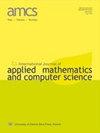A hybrid two-stage SqueezeNet and support vector machine system for Parkinson’s disease detection based on handwritten spiral patterns
IF 1.2
4区 计算机科学
Q3 AUTOMATION & CONTROL SYSTEMS
International Journal of Applied Mathematics and Computer Science
Pub Date : 2021-12-01
DOI:10.34768/amcs-2021-0037
引用次数: 15
Abstract
Abstract Parkinson’s disease (PD) is the second most common neurological disorder in the world. Nowadays, it is estimated that it affects from 2% to 3% of the global population over 65 years old. In clinical environments, a spiral drawing task is performed to help to obtain the disease’s diagnosis. The spiral trajectory differs between people with PD and healthy ones. This paper aims to analyze differences between handmade drawings of PD patients and healthy subjects by applying the SqueezeNet convolutional neural network (CNN) model as a feature extractor, and a support vector machine (SVM) as a classifier. The dataset used for training and testing consists of 514 handwritten draws of Archimedes’ spiral images derived from heterogeneous sources (digital and paper-based), from which 296 correspond to PD patients and 218 to healthy subjects. To extract features using the proposed CNN, a model is trained and 20% of its data is used for testing. Feature extraction results in 512 features, which are used for SVM training and testing, while the performance is compared with that of other machine learning classifiers such as a Gaussian naive Bayes (GNB) classifier (82.61%) and a random forest (RF) (87.38%). The proposed method displays an accuracy of 91.26%, which represents an improvement when compared to pure CNN-based models such as SqueezeNet (85.29%), VGG11 (87.25%), and ResNet (89.22%).基于手写螺旋图案的两阶段SqueezeNet和支持向量机混合系统帕金森病检测
摘要帕金森病(PD)是世界上第二大常见的神经系统疾病。如今,据估计,全球65岁以上人口中有2%至3%患有此病。在临床环境中,执行螺旋绘图任务以帮助获得疾病的诊断。PD患者和健康人的螺旋轨迹不同。本文采用SqueezeNet卷积神经网络(CNN)模型作为特征提取器,支持向量机(SVM)作为分类器,分析PD患者手绘图与健康受试者手绘图的差异。用于训练和测试的数据集包括514张来自不同来源(数字和纸质)的阿基米德螺旋图像手绘图,其中296张对应于PD患者,218张对应于健康受试者。为了使用所提出的CNN提取特征,需要训练一个模型,并使用其20%的数据进行测试。特征提取结果为512个特征,用于SVM的训练和测试,同时与其他机器学习分类器(如高斯朴素贝叶斯(GNB)分类器(82.61%)和随机森林(RF)分类器(87.38%)的性能进行比较。该方法的准确率为91.26%,与纯基于cnn的模型(如SqueezeNet(85.29%)、VGG11(87.25%)和ResNet(89.22%))相比有所提高。
本文章由计算机程序翻译,如有差异,请以英文原文为准。
求助全文
约1分钟内获得全文
求助全文
来源期刊
CiteScore
4.10
自引率
21.10%
发文量
0
审稿时长
4.2 months
期刊介绍:
The International Journal of Applied Mathematics and Computer Science is a quarterly published in Poland since 1991 by the University of Zielona Góra in partnership with De Gruyter Poland (Sciendo) and Lubuskie Scientific Society, under the auspices of the Committee on Automatic Control and Robotics of the Polish Academy of Sciences.
The journal strives to meet the demand for the presentation of interdisciplinary research in various fields related to control theory, applied mathematics, scientific computing and computer science. In particular, it publishes high quality original research results in the following areas:
-modern control theory and practice-
artificial intelligence methods and their applications-
applied mathematics and mathematical optimisation techniques-
mathematical methods in engineering, computer science, and biology.

 求助内容:
求助内容: 应助结果提醒方式:
应助结果提醒方式:


